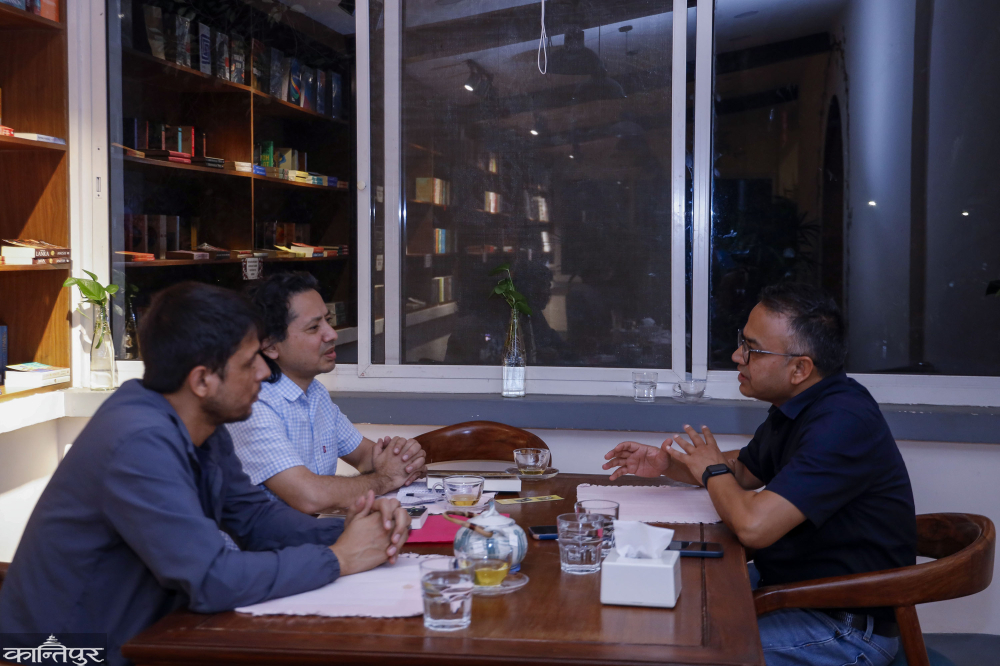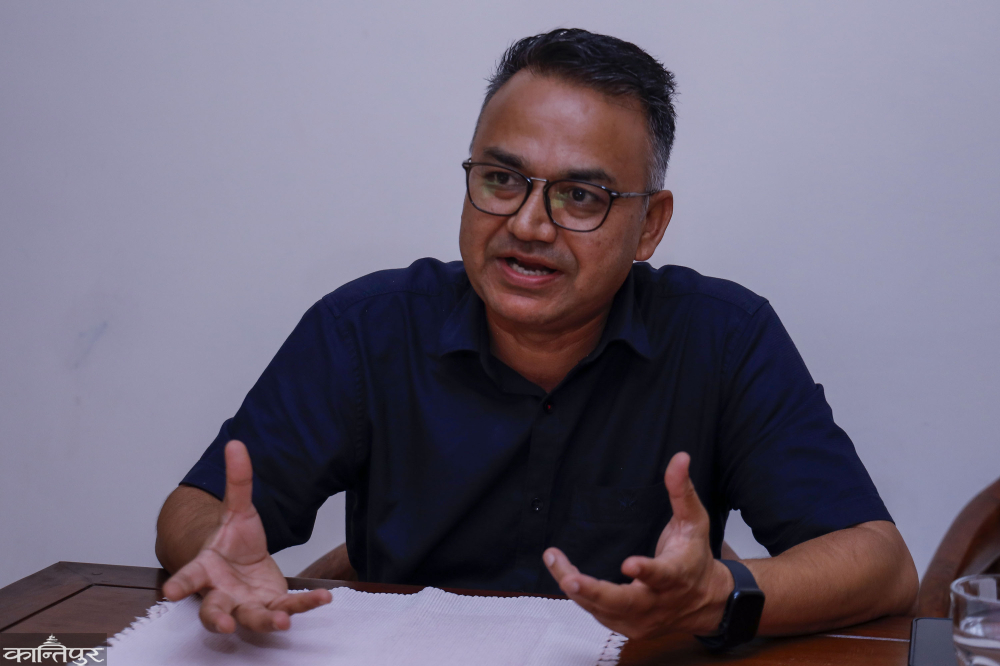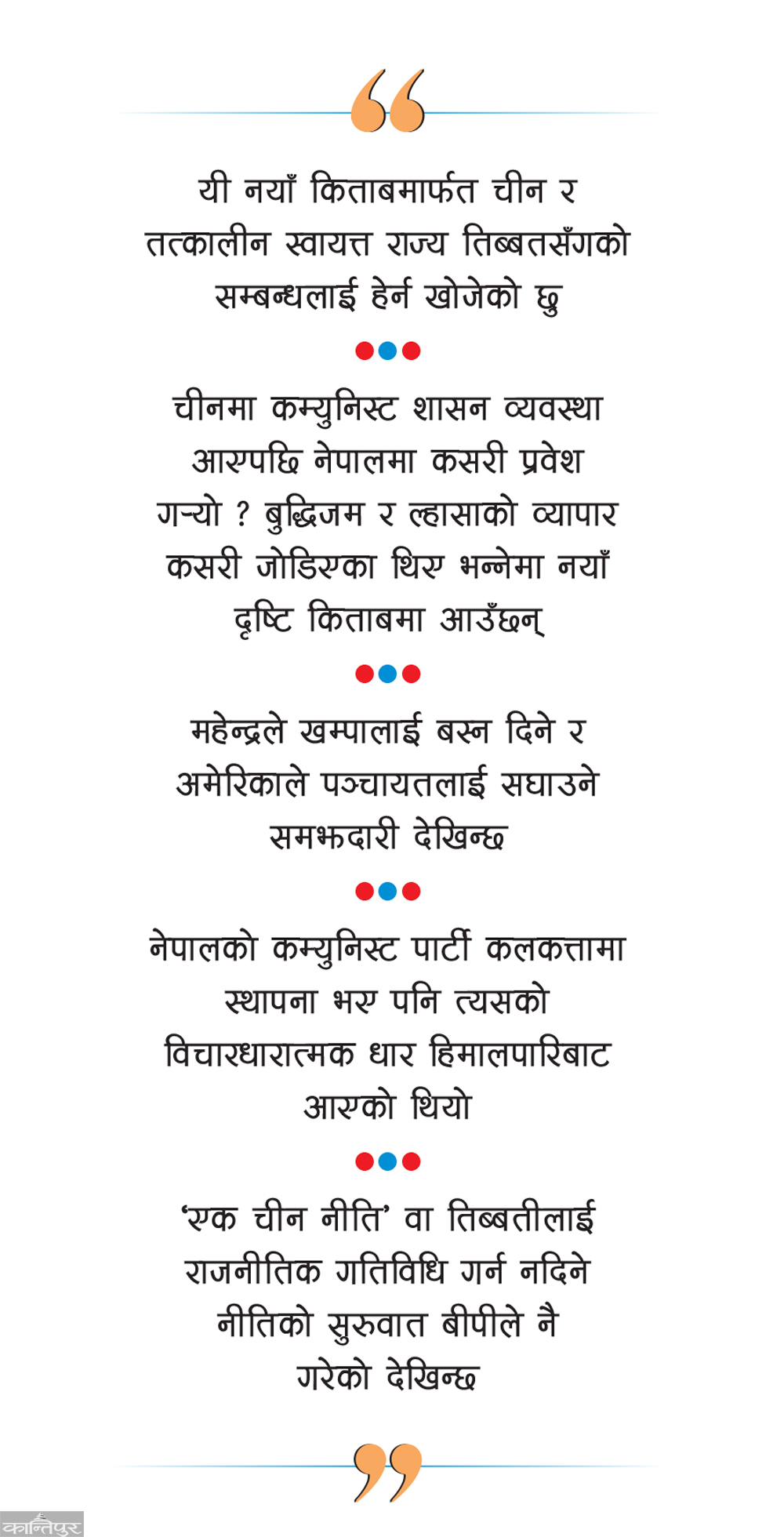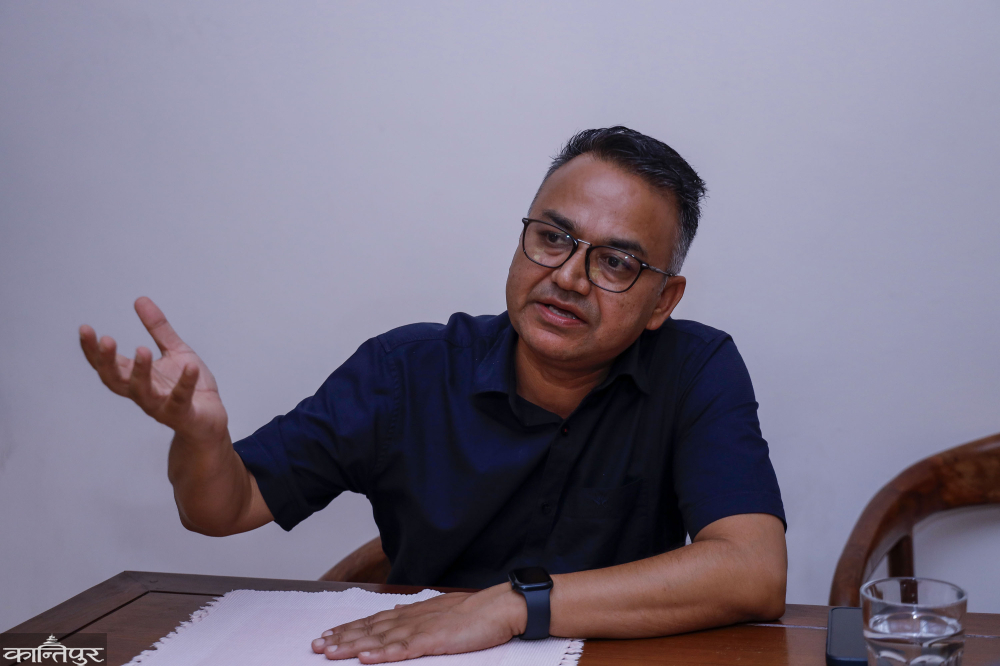"What India did in Nepal, China is doing the same mistake"

We use Google Cloud Translation Services. Google requires we provide the following disclaimer relating to use of this service:
This service may contain translations powered by Google. Google disclaims all warranties related to the translations, expressed or implied, including any warranties of accuracy, reliability, and any implied warranties of merchantability, fitness for a particular purpose, and noninfringement.




Writer and journalist Sudhir Sharma has brought two books together. Based on the cultural, economic and political relations between Nepal and China from history to 2008, he has written the book 'Monks, Business and Rebellion'. Similarly, there is an article on the dimensions of relations after the establishment of the republic in Nepal, "Himalapariko Huri".

Himalpariko Huri has discussed the relationship with Nepal in the background of China's ambitions and influence in the world system. On the eve of the release of the book, Umesh Chauhan and Kishore Dahal of Kantipur spoke with Sharma –
You have come up with a 'tweens book' at once . Both the titles of the books present a reference to the northern geography . The title of the first book is - Monks, Trade and Rebellion. Monks represent cultural, business represents economic, and rebellion represents political relationships . What are the characters and roles of the characters in your book as monks, merchants and rebels?
I wrote the internal politics through the background of armed conflict in previous books 'Laboratory' and 'Nexus'. Through that, I wanted to see the relationship towards India. But through this new book, I have tried to look at the relationship with China and the then autonomous state of Tibet. But India and America also come in places in the book . The first of the two books (Monks, Trades and Rebellions) looks at history . It covers the period from the seventh century to 2008. In the second book (Himalapariko Huri) I have looked at the period after 2008 . Since then, I have tried to find out what kind of ups and downs have come, how China's involvement has been.
I have used 'Monks, Trade and Rebellion' symbolically. Let's talk about monks, this is where the Vajrayana line within 'Buddhism' was developed . It was exported to Tibet as 'soft power' in the 7th/8th century. When there were big Viharas like Nalanda, Vikramsheela in North India, there was a dynamic relationship with the Viharas of Kathmandu. That relationship played a role in building monasteries and centers of knowledge in Tibet. There are still hundreds of temples in Kathmandu. But not as a center of knowledge as before. At that time they were centers of knowledge as well as centers of meditation. Mathematics, astrology, astronomy, medicine were also taught there. In medicine, there were separate books for each disease. Until then, there was study. In history, there is a connection of knowledge through North India, Nepal's Kathmandu and Tibet to China. I have searched for the topic of the role of monks up to modern times. On the other hand, we had a monopoly on trade with Tibet. I have also talked to some living characters for this . Panchveer Singh Tuladhar, who shared a meal with the Dalai Lama while sitting in the Potla Palace, is in Kathmandu. I have also made him a character in the book . Similarly, I have also spoken to Prajna Ratna Tuladhar, an eyewitness to the night riots when China controlled Tibet in 1959.

Another topic is rebellion . How did the communist party, communist politics and the politics of rebellion enter Nepal after the communist regime came to China? The book provides a new perspective on how intellectualism and trade in Lhasa were connected. Although the Communist Party of Nepal was established in Calcutta, its ideological edge came from across the Himalayas. After the year 2007 Dr. KI Singh and Gauri Bhakta Pradhans rebelled here and went to China, and based on the new facts, I have made the story of the communist party there giving them shelter. The topic of Khampa Rebellion is also mentioned.
Especially before the industrial revolution, two-thirds of the world's GDP was in Asia, and it is said that 50 percent was in China and India. Overall, if this region was prosperous, how much benefit did Nepal get from it? How prosperous was Nepal itself? What does your study say?
Looking at it from today's point of view, the prosperity of Kathmandu at that time does not match . But looking at the relativity of the time, Kathmandu was developed . There was also a reason for that. Because Nepalese had a monopoly on trade in Tibet, especially the Newa moneylenders. Kathmandu also got the political, diplomatic and military privileges of voting and the right to print currency. There was also a monopoly in the gold trade. Agricultural production was good but the population was low and sufficient. As there was extra income, the basis for the development of art, culture and knowledge was prepared here. As you said, China and India were the first and second economies. Kathmandu was able to benefit by being their intermediary trade center. At that time, Kathmandu was like a global city. Armenians, Kashmiris, Iraqis, Afghans and Persians used to come to Kathmandu and trade here in the latter part of the Malla period. Europeans used to reach Tibet from India via Kathmandu. Kathmandu was developed as a prosperous city in the Himalayas.
Most of the time, Nepal dominates or at least balances the political relationship with votes. From the Treaty of Vetravati to the Treaty of Thapathali, Nepal was able to balance the votes. After China came to Tibet, did Nepal lose that balance? China's power is one reason, what is Nepal's own weakness?
When India and China were the first and second economies, Kathmandu was comparatively prosperous. At that time, Kathmandu benefited from being the center of trade. Palaces, monasteries and statues that are still seen as historical heritage in Kathmandu were built at that time. In addition to Vajrayana, we were able to produce and export artists as soft power. In addition to Araniko, many other artists created the heritage of Tibet and China. Thus, as long as Tibet is autonomous, the relationship between Lhasa and Kathmandu looks very 'vibrant'. After Communist China took over Tibet, people-level relations collapsed. Until then, Nepali monopoly with Tibet was lost. Although we recognized Tibet as an independent and autonomous country, we left it while establishing diplomatic relations with China. Especially since the time of King Mahendra, people-level relations faded away, relations between states came to the center .

Let's talk about King Mahendra, he kept the diplomacy with China and India in balance, and even managed to "engage" America. Together with India and the West, the East-West Highway and the Kodari Highway with China were also built. How does your book rate King Mahendra?
I think Raja Mahendra is a very 'action oriented' leader . That's why they started to 'take over'. India dominated Nepal after 2007. He tried to get the country out of it since he was the Crown Prince . He seems to understand that if we do not create a separate identity, there will be no independent existence of Nepal. Under the same understanding, he tried to expand relations with China. After becoming a king, he started doing it. After taking power in 2017, the Kodari highway was also opened with China. Despite India's opposition, he believed that if 'access' was opened to the north, there would be balance in the south as well. To some extent that was also true . But along with that, it seems that he has also made 'compromises' such as accepting Everest as half and making a border agreement with China by keeping the trilateral point in Kalapani open.
He did not let the relationship with China go beyond a limit . Mahendra never entered into a military agreement with China. They didn't take arms . His policy seemed to be to take relations with China as a political weapon to support his governance and panchayat but not to go too far . Improved relations with India by showing China. Especially after the war of 1962, the Indian Prime Minister Jawaharlal Nehru was also in a weak state in terms of health. He also reached the end of his life . At this time, Mahendra increased the relationship with Delhi by showing the developed relationship with China. After that, Delhi supported Mahendra and his panchayat system.
Mahendra also maintained a close relationship with America. Looking at the history and the now 'declassified' documents, it is known that the 'Panchayat Development Project' was run with the help of the 'American Assistance Mission'. The Panchayat Ministry was established with American support. The panchayat training center was established by American experts. 'Ford Foundation' had a big involvement . The Americans did the work of 'growing and flourishing' the panchayat system. Mahendra is also the only head of state in Nepal who has visited America twice. In the book, I have 'quoted' the memoirs of the old ambassador of China, Yang Kongsu. He wrote - "Mahendra was so smart that he maintained a good relationship with us". He also maintained good relations with India by showing us. He also kept a close relationship with America by showing both of us . But despite that, China did not have a 'hospitality'.' He is such a king, who allowed the anti-Chinese Khampa rebels to live in Nepal, but did not let the relationship with China deteriorate . He made a deal with the US to allow Khampa to stay here. On the one hand, there was an 'exchange' between the two sides about allowing Khampa to stay here and on the other hand, America would help the Panchayat. It was 'broken' during the time of Birendra.

However, the situation of India's military checkpost remaining in the Kalapani region of Nepal's north-west border was also created during Mahendra's time, right?
Yes, Kalapani, Lipulek region is the trilateral point of western border of Nepal . Due to the many disputed sites, we have not been able to have a border treaty with India. But we also made a border agreement with China during BP. And Mahendra signed the boundary treaty. There are also various maps included. I have also put one of those maps in the book . In that treaty, the trilateral point between Nepal, India and China to the east is specified, but not to the west. If the trilateral point had been decided at that time, perhaps the Lipulek-Kalapani dispute would not have arisen now. But when Mahendra kept it open, it became easy for India to come and live there . Also, the Indian army was already in the knowledge of the palace that was stationed there . But they did not pressure to remove it because India would get irritated. When Kirtinidhi Bista removed 17 of the 18 checkposts placed by India in Nepal during Mahendra's time, the 18th checkpost that was not removed was that of Kalapani. It was impossible to know about 17 but not to know about one. But the monarchy turned a blind eye. Looking at it from another point of view, it can be said that '17 checkpoints have been removed'. There was also an argument that if leaving one would remove 17, why not do that? But it is also true that the king closed his eyes .
One chapter of your book is dedicated to Mao and Mahendra. Mao is a communist leader, Mahendra was a 'feudal' king. How was the relationship between these two?

They met 'physically' only once. Instead, China's Prime Minister Zhou Enlai and Mahendra have met outside on various occasions. From that relationship, Mahendra must have had a continuous indirect dialogue with Mao . But Mao seems to believe him . In the beginning, it seems that Mao sent various messengers to understand what kind of person Mahendra is. I have also quoted the conversation between King Sinhanuk of Cambodia and the Chinese leaders, and in other conversations including that, they say - Progressive is the king of Nepal more than Marcos of the Philippines. The idea that Mahendra would have been a communist if he had not been the king of Nepal has also come from Mao. He seems to have kept Mahendra as a close friend. Although Mao was a republican communist, why did he have a relationship with the leader of Nepal's monarchy, who is considered a representative of feudalism? From the history, even the Emperor, Mao or the current Xi Jinping, it seems that their national interest is more priority. As long as the monarchy remained, they regarded it as a close friend.
When talking about the monarchy, it seems that from Mahendra to Birendra and later to Gyanendra, they sought to take over from China . Their priority in using the relationship with China is more visible, what kind of benefit did they get or suffer from it?

Mahendra seems to be the smartest. But Mahendra went to China once, Virendra went ten times. Birendra also visited Tibet for the first time as the head of state. Before that, China did not take the heads of state of other countries there . Birendra seems to have a relationship of trust. However, Mao does not seem to trust Virendra at first . Mao asks Nepal's leader Kirtinidhi Bista, who has close ties with China - 'Can this Birendra be trusted? He has studied in Japan, America and UK. Initiated by western education . Is he like Babu (Mahendra) or not?' Mao seems to understand Birendra from other sources as well . Birendra also seems to be very close to China . As soon as he returned from his visit to China, he became the king and immediately went to visit China again, then immediately started military operations against the Khampas that Mahendra had allowed to stay. It was very sudden . Because, there was intelligence involvement of India and America in helping the Khampa rebels . This topic was a big part of geopolitics. At the same time, there was also a deal about the US helping the Panchayat and the Rajtantra helping the Khampa.
Both America and India were not happy with the action against Khampa. Due to this, Virender's relationship with America and India remained doubtful. In the year 2045, he feels a big 'threat' from India. They decide to bring 'anti-aircraft guns' from China. It brought a big geopolitical wave. Before that, it seems that the merger of Sikkim and the establishment of Bangladesh was very longed for. Relations with China seem to be guided by the same incident. How much he succeeded or failed is a matter for the review of history . But, suddenly there was a palace massacre. The Chinese present all these things as a big conspiracy . Although China has not expressed an official view, academics close to the establishment whom I have interviewed paint a picture of a larger conspiracy. He also says that this happened as a result of Birendra's historical relationship with China. But since they did not give any basis for it, we also cannot do it . However, after Kissinger and Nixon's visit to China, the relationship between America and China improved and Virendra gets favor. I have also quoted in the book, after Indira Gandhi annexed Sikkim to India, there was a dialogue between American President Gerald Ford and Chinese leaders including Mao - 'Wouldn't Indira Gandhi intervene militarily in Nepal?' If the railway is not built, until then I cannot help Nepal much, the stake in Nepal will not increase'. That policy is also seen in the current Chinese policy makers .
Raja Gyanendra seems to have taken a very big risk politically in the hope of getting China's support. He lost more than he gained, didn't he ?

Gyanendra's image is commercial. He does not have a close relationship with China. On the other hand, there was a good relationship with India in terms of trade. But when he did 'Ku', then relations with India deteriorated . After that, it seems that it has moved forward by establishing relations with China as the main basis for sustaining its politics . Accordingly, he brought a proposal to make China a member of SAARC. After that, relations with India worsened. But what is the scope of your relationship with China? Gyanendra does not seem to be able to objectively assess how other forces can take revenge due to his relationship with him. Even when the people's movement of 2062/63 was going on here, the Chinese embassy was giving support to Gyanendra. At that time, the Chinese State Councilor visited at a very important time, after which their understanding towards Gyanendra seems to have changed . It seems that the Chinese policy is proceeding from the middle of the two lines . After the success of the movement, Gyanendra's power will go . The monarchy is gone. But despite decades of relations, China does not seem to have tried or tried to protect it.
Another big leader who has close relations with China after Rajas is BP Koirala . BP had a more specific relationship with Chou En Lai than with Mao . What was BP's China policy and geopolitics?

BP Koirala was the leader with the most international image among his contemporaries. He had close relations with many world leaders, had 'exposure' and watched world politics closely. He seems to be 'open minded'. The Dalai Lama fled when the Congress had won the elections but BP had not become the Prime Minister. At that time, Nehru also pressured BP to make a common opinion about it and to oppose China. Congress general ministers also issued statements. Even though BP has partially adopted it, after taking the oath of the Prime Minister, they say that they cannot get too involved in the Tibetan affairs in view of the national interest. He seems clear that he will grant asylum to Tibetans on humanitarian grounds but not allow them to engage in politics. In fact, BP seems to have initiated the 'one China policy' or the policy of not allowing Tibetans to engage in political activities. Therefore, it seems that he has a good understanding of the extent and scope of national interest. His other 'hidden agenda' is not seen in it . He has also fallen out with Nehru on many issues. Even during the 2017 scandal, he did not have a good relationship with Nehru. In this way, BP's relationship with both India and China is not good when it takes a stand in favor of national interest .
BP seems to have a friendly relationship with Chow En Lai . Although not on the list when BP went on a visit to China, he stayed at Chou En Lai's house all day, both wives cooked Nepali and Chinese food, and they had a friendly relationship. Similarly, when Chow En came to Nepal, both of them sat on the 'boat' in Pokhara and settled big things. It was BP Koirala who made peace and friendship treaty with China. It also seemed to be China's answer to the 1950 Treaty of Peace and Friendship with India. Even though the treaty with India is unequal, it is not so with China. At that time, China was trying to negotiate a peace and non-aggression pact, which it had done with Burma. Although Mao pressured, BP did not agree . He took a stand of rejection saying that making a non-aggression pact would be strategically like staying in China's military alliance. In terms of national interest, that seems to be right.
Similarly, at that time, there was a dispute about Everest being Nepal or China. It seems that BP outright rejected Mao's proposal to halve Mount Everest . It also seems to deny that we should make a border treaty directly. Instead, it seems that Mahendra came later and made an agreement that Everest is half and half. But BP refused to open the Kodari highway. BP itself has not clarified the reason for that. Mahendra opened it. Nepalese soldiers are killed when Chinese troops enter Mustang, BP appears to have taken a stand on his side despite his friendly relationship with Chou En Lai . Therefore, it seems that he has taken his stances based on the national interest . Chow En Lai seems to understand that well . Looking at the documents, it seems that BP has openly stated its views . While Mahendra's matter does not seem to be open . In this way, BP has taken a clear stand and it seems that the ground has been laid for Mahendra to 'take over' in the year 2017 after falling into geopolitical chaos.

Kings Birendra and Gyanendra appear to have a slightly more exaggerated reliance on China . But the monarchy did not survive. He didn't even try to save . After that, how did China adjust itself to the new system in Nepal?
I have written about 2008 in the 'preface' of the second book (Himalapariko Huri). This year is important in many ways for Nepal and China. In that year there was an economic recession in the world . It shook the western world badly. Banks were broke. The financial system was affected. At the same time, China held the Beijing Olympics. He showed the world the power he had gained through the Olympics. Since then he had adopted an active foreign policy. From Africa to Latin America, it seemed to be advancing in terms of leading the world as a new kind of 'imperialist power' by occupying various mines. Although he was becoming active all over the world, he was missing many things in Nepal at that time. Near him in Nepal was the formal end of the Mitrashakti Monarchy and the declaration of the Republic. A new type of political system had come but it was not known what it would be. India had more role in it. So the 'stake' of the Chinese side was weak . With the involvement of the United Nations in the peace process, the participation of Western powers also increased. China was also shocked by that. In the same year, the longest demonstration of anti-China Tibetans took place in Kathmandu. That was a big headache for China. He then sent several delegations and research teams to Nepal. It seems that a conclusion has been reached only after observing the situation by sending several different teams from think tanks, government agencies, the Ministry of Foreign Affairs, and universities.
After 2008, he became so active in Nepal that he became the first Chinese ambassador to present the certificate of status to the then Acting President Girija Prasad Koirala after the Republic of Nepal came into being. In other words, China became the first country to express formal solidarity with the Republic. He went that far . Even then he was increasing his role . Not only in politics, but other dimensions of society advanced in the economic sector . Handed in tourism . Focused itself on softpower . Even India has not only protested and disagreed with the Constitution of Nepal, which was made as the final result of the peace process that started with its own facilitation, but also imposed a blockade on Nepal. But China gave political support to the process of issuing the constitution. Visibly and invisibly, he ignored the Congress, UML, Maoists and some Madhesh-centric parties. Thus, India was aggressive and China was defensive in 2008 regarding Nepal. However, by 2015, China became aggressive, India, which was on the defensive, showed aggression through blockade.
Our society and rulers seem to be a little more optimistic about China, but do they seem to behave accordingly or not? Because Nepal sought China's trust during the Anglo-Nepalese war, Gyanendra had hoped during the second people's movement. Similarly, in the environment when India imposed blockade in 2015, the role of China was not seen as expected by Nepal.

Emperor of China, including Mao, Deng Xiaoping or Xi Jinping, seems to have adopted the same permanent policy in all periods. That is, he has prioritized his national interests. Ideological subjects are auxiliary matters . As during the war with the British, even though Nepal repeatedly tried for Chinese help, they did not help. At that time, he did not help Nepal after concluding that the British were not interested in Tibet. There are other reasons for that. Another thing, he did not have the power to protect the monarchy. Didn't even do that . Until 2008, he was more concerned with Tibetan interests. There seems to be a policy of not doing big activities in Nepal until it is pushed. But there is a difference between the sky and the ground in China before and after 2008. Since then he has actively participated in Nepal's internal politics. It seems to have reached the vicinity of India at some point. His involvement has increased . It seems that his efforts have started to join in building and destroying this government and that government, this coalition and that coalition. I think that China is doing the same mistake that India did. Now he doesn't seem to be as carefree as yesterday . When India imposed a blockade in 2015, China was on the side of not spoiling its relations with India. But after the tension of Doklam and the clash of Galban, their relationship broke . But if China's policy in Nepal is contradictory, it also wants to enter Nepal and increase its activities and influence. But again, China does not want to spoil relations with India. Even during the 2015 blockade, China did not openly support Nepal. China also did not want to do the MoU regarding bringing petroleum products from China to Nepal. The reason behind that is, he didn't want to spoil the relationship with India . But the current situation is different. There is a personal bitterness between Xi Jinping and Narendra Modi. In that case, China does not seem to be facing India . However, China's concern in Nepal is America rather than India. Because, along with the US, China is tussling globally and a new cold war situation has become . Its remnants have started to be seen in Nepal. China and India are not in the same situation as they were yesterday. With the growth in the economy, their aspirations and involvement have increased more than ever. America and collective western powers have increased interest in Nepal. Such a situation is both an opportunity and a risk for Nepal. How to not allow the risk to increase and how to benefit from the geopolitical competition is the burning question facing the state of Nepal today.
 प्रकाशित : भाद्र २९, २०८१ ०९:२०
प्रकाशित : भाद्र २९, २०८१ ०९:२०

 २८.१२°C काठमाडौं
२८.१२°C काठमाडौं














